Welcome back to Rule of Three, a series in which I take an in-depth look at three related comedy films, weekly, beginning on April Fool’s Day. They could be films in the same series, films by the same director, films with a common theme, or films with any relationship, really. It’s a spinoff of the Trilogy of Terror series, but with less disemboweling.
I started this series looking at three Jim Henson-era Muppet films, which was an easy choice for me, because the Muppets were and remain an important creative presence in my life. This year, I’m going to look at another of them: Pee-wee Herman.
I’m pretty sure that when I was a kid, VHS cassettes were still quite expensive. I have no idea how much my parents paid for our copy of Pee-wee’s Big Adventure, but I can assure you they got their money’s worth.
I loved Pee-wee’s Big Adventure. I don’t mean that I watched it a lot or enjoyed it or never really got sick of it. Those things are all true, but those things aren’t love.
And I loved this movie.
This was one I turned to again and again. One I’d watch with my brother. With friends when they came over. By myself if I was bored. And if I was at somebody’s house and they had a copy…well, we’d watch that copy, because a lot of people owned it and we all sure loved it.
Which is kind of funny, looking back, because the central joke of the entire film — the incongruous and absurd nature of Pee-wee himself — isn’t something I ever picked up on as a kid. Paul Reubens — who created and played the character — made Pee-wee seem so effortlessly fun to spend time with that we never questioned anything about his nature. About who he was. About how strange he was. To us…well…he just seemed like an exceptionally relatable adult.
And we loved him for it.
I distinctly remember catching Pee-wee’s Big Adventure on television at some point when I was in college. It was probably on Comedy Central, or something, and I tuned in at about the time Pee-wee hitches a ride from escaped convict Mickey. I sat and watched it, expecting to be embarrassed. Amused, maybe, but overall a bit ashamed at whatever silly nonsense used to appeal to me so.
I was a literature major at the time, and a philosophy minor. I was older. I spent my time reading great novels and writing worse ones. I still stayed up with friends late into the night, but instead of watching cartoons and playing video games we were studying and creating and having discussions. I had grown up. I had outgrown so much. Surely, clearly, I had outgrown this.
I didn’t. And I was shocked at just how funny Pee-wee’s Big Adventure still was to me. In fact, it was a better film than I ever remembered it being.
If you haven’t seen the movie since you were a kid, you’re probably questioning my sanity about now. So watch it again; I promise you, it’s worth revisiting through adult eyes. It will remind you of what it was like to be a kid, but it will also give you a chance to see just how infectiously charming a production it actually is.
Pee-wee’s Big Adventure was released in 1985. I had always thought it came after (or during) Pee-wee’s Playhouse, but that show didn’t debut until 1986. Pee-wee Herman as a character originated in the late 70s, but audiences didn’t get to see him in any major venue until 1981, when Reubens created a stage show for him. The show was moderately more adult-oriented than the later Pee-wee outings, but the character himself was more or less in place already.
So, what was the character?
It’s…hard to say, really. Pee-wee Herman himself is, at the very least, anachronistic. He’s like a 1950s toddler trapped in an adult’s body, though only rarely does anybody treat him that way. He seems to have a child’s mind and sense of humor, and certainly has a child’s concept of what is and is not important.
He’s a bit of a brat, a bit selfish, and comically oblivious. He also has a tremendous amount of energy, which is humorously at odds with his button-down appearance. He’s a circus clown perennially dressed for a job interview.
And that’s something I never actually noticed as a child. I don’t think I was old or perceptive enough to pick up on the fact that adults didn’t actually dress that way. To my uneducated eyes, Pee-wee checked out. Why wouldn’t grown-ups walk around in a grey suit and red bowtie?
Pee-wee never seemed ridiculous to me. How could he? He was living the life every child hoped to lead when he or she grew up. No job, plenty of friends, all the toys he could ever want…whether in his Big Adventure home or the Playhouse, Pee-wee seemed to have it all. Isn’t that exactly what we hoped getting older would entail? Sure, we’d have to go to school and get a job…but if it was all in service of us getting our own space to fill with any toy, game, or curio we wanted, wasn’t that worth it?
But then, you grow up. We all do. That’s every child’s tragedy.
Falling down and scraping your knee is replaced with losing your job. The squabbles you have on the schoolyard are replaced with betrayals that permanently end relationships. The hope that you get the popular new toy for Christmas is replaced by the worry that you won’t be able to pay the rent this month.
Your priorities change. Your focus changes. Your outlook changes. Your life changes, and, once it does — and it always does — you can never go back.
When I saw Pee-Wee’s Big Adventure in college, I figured I might enjoy it, but I knew I wouldn’t love it. I couldn’t. It represented another, earlier version of me. One I literally no longer was. After all, if you traveled back in time and met yourself at age 10, how much would the two of you actually have in common?
A rhetorical question, obviously, but one which probably does have an answer: entertainment.
Not all entertainment, mind you, but the best films and television shows suitable for children also appeal to adults. That’s because nobody likes being treated like an idiot. Children are a bit more tolerant of it than adults are, but they prefer to be treated with respect. They prefer to be engaged with. They prefer to feel like they belong. And a film or television show that does that for a child will likely do it for an adult, too.
Pee-wee Herman headlined both a film and television show that did exactly that. They appealed to children without pandering, and was able to hold an adult’s attention as well. Children could laugh with Pee-wee, and adults could laugh at him. Parents and children were both enjoying the same jokes in different ways. Like the character, the comedy itself was a child dressed like a grownup. Suited to both audiences.
I could talk for ages about Pee-wee’s Playhouse, but I did that already. Instead, I’m going to focus on the film, and why that, specifically, holds up and succeeds.
Here’s why it, specifically, holds up and succeeds: the tremendous amount of talent that went into it.
Pee-wee’s Big Adventure could have been nothing. A rambunctious, silly outing about some bizarre eccentric losing his bicycle and chasing it all over creation. I mean, reading that sentence, how could it not have been nothing? What I’m trying to say is that the film so easily could have lacked creative, artistic, and comic merit entirely, and we wouldn’t have a right to complain. When Beverly Hills Chihuahua got bad reviews, did anyone even care? What did people expect? Of course it’s bad; just look at it!
But Pee-wee’s Big Adventure knows better. It knows that no matter how frivolous, absurd, or uncomplicated your plot is, it — like your audience — deserves respect. Pee-wee’s Big Adventure could have been a longform experiment in anti-comedy, and nobody could possibly begrudge it for taking that approach. Instead, the creative minds behind the film took their decidedly idiotic setup and tried to figure out a way to make it good.
I don’t need to make a list of films that took the easiest way out, hoping to coast on a gimmick or a star or a license; you can already think of dozens. Many of them even had talent behind them. The problem was that the talent wasn’t used. It wasn’t deemed necessary. They decided that the film would be good enough without trying, so why try?
Pee-wee’s Big Adventure tries, and it answers that question: because the fruits of success will be so much greater.
Sure, it probably could have coasted on its quirk or the recognition of its title character. But by putting so much talent to use, the minds behind the film gave it life.
Enough dancing around it. Who is this talent?
There’s Paul Reubens, obviously. Reubens was — and remains — a talented comic actor, and by the time of this film he’d been performing as Pee-wee Herman live on stage for around four years. That gave him plenty of time to hone the character, to learn firsthand what did and did not work, and to get a deep sense of what audiences wanted from the Pee-wee experience.
Part of the reason I was so surprised to learn that Pee-wee’s Big Adventure came before Pee-wee’s Playhouse is that the character here feels so…complete. It feels like something that had been developed and lived in and built from the inside out week after week for years. Sure enough, it was…just not anywhere I was looking.
Reubens faces a difficult balancing act with Pee-wee. The character has to register as annoying, but he shouldn’t annoy the audience. We need to be on his side, but he’s nothing like us or anybody we know. He needs to be somebody we’re interested in watching on screen, while he has neither any heroic nor villainous traits to speak of. The fact that Pee-wee was so popular for so long is entirely down to Ruebens understanding how delicately to work the controls. Push hard over here, ease up over there, let this moment ride for exactly this long…
And, unquestionably, Reubens derserves much of the credit for making Pee-wee’s Big Adventure work. But it’s also down to the material, which Reubens wrote with Michael Varhol and Phil Hartman.
Phil fucking Hartman.
I somehow never realized before writing this review that Hartman worked on the script. I knew he and Reubens were friends; Hartman played gruff seaman Captain Carl in both the live Pee-wee shows and Pee-wee’s Playhouse, and he appears in Pee-wee’s Big Adventure briefly as a reporter. But the fact that the late, immensely talented, much-missed, brilliantly funny Phil Hartman sat down at a typewriter and helped Reubens write the film goes a long way toward explaining why it works as well as it does. He knew how Reubens worked best, how the character worked best, and had a profound understanding of the nature and rhythm of comedy.
There was no better possible cowriter.
Pee-wee’s Big Adventure is remembered as a sequence of big moments and setpieces, but the most surprising thing when re-watching the film is just how memorable all of the moments and setpieces are. There’s no single showstopper and no real filler material; every scene is clearly, obviously crafted to be as successful in isolation as any other. Honestly, during this rewatch, I realized that I could have told you literally everything that happens in the film, despite having not seen it for years. I probably wouldn’t have gotten the order of the scenes correct, but I sure as hell remembered every damn thing Pee-wee did on his cross-country journey to retrieve his bike.
That’s the mark of strong writing; Reubens and Hartman made everything that happened memorable. Pee-wee being chased around the big dinosaurs at the truck stop. Pee-wee wrestling Francis in the massive bathtub. Pee-wee crossdressing to elude the law. Pee-wee singing with a hobo. Pee-wee hitching a ride with Large Marge. Pee-wee rescuing animals from a burning petshop.
In a film so impressively, defiantly committed to a plot that doesn’t matter, everything feels like it matters.
And, of course, I can’t neglect to mention the rightly revered “Tequila” scene, in which Pee-wee angers a bar full of bikers and wins them over with an impromptu dance to the classic Champs song. (The bikers are part of a gang called Satan’s Helpers, which I didn’t remember and which made me laugh quite hard this time through.)
It’s such a famous scene that if you Google “Pee-wee shoes” you’ll find the platform footwear specifically from this scene — despite the fact that he only wears it for a few minutes and it isn’t even his. I’d even wager that this film is the only reason many people my age know “Tequila.” (It’s certainly the reason we know there’s no basement at the Alamo.)
I actually remember the first time I heard “Tequila” on the radio, when I was about 10 or 11 years old. I was in the car with my parents and my mind was absolutely blown. It was a real song? To this day I can’t hear it without thinking of Pee-wee’s desperate, silly dance, and while my tastes have matured this is still one of my favorite musical moments in film ever.
So we have the leading man and the script…but that’s not all that makes Pee-wee’s Big Adventure great. There’s also the direction, which is bottomlessly inventive, colorful, and confident…playing the silliness straight without losing an opportunity to lean into a great visual gag.
Who directed it? Tim fucking Burton.
Of course, at the time Tim Burton was a fresh-faced nobody. Pee-wee’s Big Adventure was his first serious gig. If he was going to go anywhere, this was likely his one chance to make an impression, and he sure as hell did.
Everybody who’s seen the film remembers his touches. They remember the way he shot Pee-wee’s elaborate breakfast machine, despite the fact that it appears only in the film’s opening. They remember the terrifying closeup on the mechanical clown after the bike is stolen. They remember the stylized lighting and angles of Pee-wee’s recurring nightmares.
Reubens brought the character and Hartman brought the comedy but Burton brought the entire, unforgettable visual approach that makes the film what it is. I’d even say that the visual inventiveness is what made so many kids love the film in the first place. Before you ever get a handle on what’s happening, or the jokes, or the innate excitement of a roadtrip, you’re already drawn in by what you see. By the vivid and striking colors. By the artfully cluttered set design. By the hypnotic movements of spinning wheels and drinking birds and endlessly flipped flapjacks. Burton created not just a film, but a universe in which Pee-wee’s outlandish eccentricities fit.
It’s a beautiful film, impressively shot for what could have been a throwaway comedy vehicle. To cite just one perfect, tiny example, there’s the understated reveal that Pee-wee’s bathroom window is actually an aquarium…a sight gag so natural that all it takes is a goldfish swimming into view to make it work.
Burton’s one-two punch of Pee-wee’s Big Adventure and Beatlejuice established him very deservedly as one of the most inventive and creative directors working at the time. Studios were so impressed with his work that for his third major film he was handed the reins to Batman.
When you see people disparaging Burton’s latter-day output, this is why. He began his career by excitably tearing into the film industry and making each moment so distinct, so personal, so unique…and seems to be intent on ending it with predictability and hollow quirk. The man who upended patterns has settled into one of his own, and that’s disappointing. But go back to his early career, and you’ll see true genius at work.
Then — oh yes — there’s probably the single best thing about Pee-wee’s Big Adventure: the score by Danny Elfman.
Danny. Fucking. Elfman.
See? I was not kidding about the talent involved with this movie. As with Burton, this film was Elfman’s first big opportunity as a composer. Prior to this he was best known for his band Oingo Boingo. After this he’d be a strongly sought-after musical talent that composed immortal themes and other tracks for The Simpsons, Batman, Beetlejuice, Tales from the Crypt, Chicago, and much, much more.
Be honest: you can hear the score to Pee-wee’s Big Adventure in your head right now, can’t you?
It really is brilliant. So unnecessarily loud and bombastic…a serious orchestra playing carnival melodies…silly compositions played with incredible drama and import. It’s the perfect soundtrack to the outsized importance of Pee-wee’s quest for his stolen bicycle, and Elfman didn’t just write some great pieces and move on to his next project; he actually tailored bits of his compositions to precise moments in the film. He ends one song on a note that falls exactly as Pee-wee licks butter from an oversized novelty knife. Much later he integrates the sound of the spurs from Pee-wee’s cowboy costume into the rhythm of another song.
Twice he actually builds pieces around sounds that are happening on screen. The first is when Pee-wee is singing an improvised tune on his bicycle in the park, and the second is when he’s pounding on his rival Francis’ door. In print that doesn’t sound like much, but knowing Pee-wee you can imagine how irregular these things might be. Pee-wee himself isn’t musical, and when he knocks he doesn’t do so with a clear or predictable pattern. Nevertheless, Elfman composes around these moments, and it helps to establish the soundtrack as being the genuine musical accompaniment Pee-wee hears in his head every day of his life.
There’s little negative that I can say about the film at all, to be honest. Perhaps the one criticism I have is the least important one: as much as Pee-wee’s Big Adventure feels like…well…a big adventure, the scope of the film may actually be quite small. Before he leaves home, Pee-wee gets a fraudulent tip that his bike is in the basement of the Alamo, so he heads right to Texas. Then he finds out that a child actor in Hollywood has it, so he goes there instead. And…that’s about it.
What’s more, we don’t know where Pee-wee starts his adventure. Sure, it could be Maine or something, which would imply a true cross-country trip even if we don’t see most of it. But since Pee-wee visits the Cabazon Dinosaurs in California before he gets to Texas, it’s possible that he started in California anyway, meaning he didn’t do much other than go to Texas and return.
But, come on, even I know that’s not a criticism, and Pee-wee Goes to Texas wouldn’t have been nearly as gripping a title. The fact is that the film feels larger than it really is, and that’s precisely the achievement that any work of art reaches for.
However much or little ground Pee-wee’s trip actually covers, it’s the experience that matters, and the experience is enhanced immeasurably by the bit characters he meets along the way. Reubens may have had all the time he needed to hone Pee-wee himself, but even the minor characters in this film feel complete and lived in. I can’t watch the scene in which Pee-wee visits Mario the magic shop owner without believing whole-heartedly that the two have known each other for years, and have amused each other with props and tricks longer than we’ll ever know. That one scene implies an entire, believable friendship.
Then there’s Mickey, fleeing the cops after cutting a tag off of a mattress. (“I got a real bad temper,” he explains.) He’s played by a guy with the excellent name Judd Omen, who’s had roles in just about everything. Mickey is the first new face Pee-wee meets on his journey, and the interplay between the hardened criminal and unapologetic manchild is some of the funniest stuff in the movie. Funnier, of course, is the fact that Mickey doesn’t tire of Pee-wee, even after the latter drives his car off a cliff. Rather, Mickey likes Pee-wee so much that he needs to leave him behind. “Look kid, I like you. I like you a lot. That’s why I can’t drag you into this,” he apologizes.
The best of the supporting characters is the Alamo tourguide, played by the also-dearly-missed Jan Hooks. It’s what should have been a thankless part, but Hooks finds a way to bring it to life. In fact, the tourguide really only needs to annoy Pee-wee by taking too long to bring the group down to the basement. She just needs to drone on and be boring, and that would sell the joke.
But Hooks, wisely, doesn’t take the character there at all. That would have been the easy way out, and Hooks goes for something far more rewarding. Her tourguide eats up plenty of time, of course, and gets right under Pee-wee’s skin as she must, but she’s actually never boring.
Hooks taps instead into a kind of relentless sunniness. The tourguide smiles widely and incessantly, chews gum, launches enthusiastically into long discussions about things that aren’t interesting at all. Her delivery of, “Yes, there are thousands and thousands of uses for corn, all of which I will tell you about right now,” belongs in a dry comedy hall of fame.
All she had to do was stand in Pee-wee’s way, but instead Hooks crafted a complete character. Someone who loves her job a little too much, and finds pride and pleasure in the mundanity that so many others overlook. (The fact that she works for San Antonio Parks and Recreation makes it very easy to see her as an accidental precursor to Leslie Knope.)
A lesser actor would have taken a Ben Stein approach, leaning into the obvious monotony. Jan Hooks, by contrast, chews gum and lights up the scene with her big, smiling eyes…which only needles Pee-wee more, and makes the sequence far funnier as well.
Then there’s Elizabeth Daily, who plays Dottie.
And, man, I love Dottie. I always have. She’s just so…wonderful. So understated and adorable. And while I never paid much attention to it as a kid, the running joke of Pee-wee utterly ignoring her romantic overtures is deeply funny to watch.
It’s only this time around that I noticed that after Pee-wee ignores her hug to fawn over his bike, Dottie turns her abortive gesture into a kind of awkward stretch. It’s so perfect and well-played.
Dottie is just a delight. While writing up this piece I wondered if she’d done much after this film and, sure enough, she has, mainly as a voice actor. She played Tommy Pickles in Rugrats, which is something else I watched endlessly as a kid and somehow never once realized. She also played the title pig in the sequel to Babe and continues to voice characters regularly in cartoons and video games. The oddest thing I learned is that she appeared on Saturday Night Live the year after Pee-wee’s Big Adventure came out…as a musical guest.
Dottie is also important for understanding how Pee-wee functions in this movie.
She cares about him, and not just romantically. She treats him with respect. She, like all of the other characters, either doesn’t notice his eccentricities or finds them passively endearing. Pee-wee is a force of juvenile energy and mischief, but she treats him the way she treats everybody else: fondly. The characters in this film, Dottie chief among them, are not only accepting of Pee-wee’s lifestyle, but are supportive of it.
However he lives, for whatever reason, he’s happy. And don’t we all deserve happiness, whatever it might represent for each of us?
The great untold joke of Pee-wee’s Big Adventure is that you’d think the ultimate lesson is that Pee-wee is too naive. That his personal, sheltered view doesn’t align with the world at large. That, once he leaves his small comfort zone, he’ll learn the hard way that life isn’t what he thinks it is.
…but that doesn’t happen. People like Pee-wee. People reach out to help him. He wins over his initial detractors, ends the film with new friends from all walks of life, and even impresses Warner Bros. so much with his heartwarming tale of bicycle theft that they make a movie out of it.
Pee-wee is just Pee-wee. No, he’s not like anyone else. But, so what?
We’re all different, in our own way. Pee-wee just happens to have no interest in hiding it.
So, no. The lesson isn’t that we all have to grow up sometime. The lesson is the opposite. The lesson is to grow up when you want to grow up, or not at all. It’s your life. And you should enjoy it. You can play by your own rules. Be a loner. A rebel.
Pee-wee’s path through life is emphatically unlike anyone else’s — within the movie or without. And that’s okay. Because he is who he is. This is his life. And people treat him the way he should be treated. Not like a pariah or a weirdo or a dope…but like a human being.
So, yes, I watched Pee-wee’s Big Adventure endlessly as a kid. Looking back on it now, through adult eyes with adult expectations, I can conclude that, in this instance at least, my younger self had pretty good taste.
Of course, three years later we’d get a sequel, and I watched that one, too.
Once.
Tune in next week, when I’ll finally bring myself to watch it a second time.
…the things I do for you people.
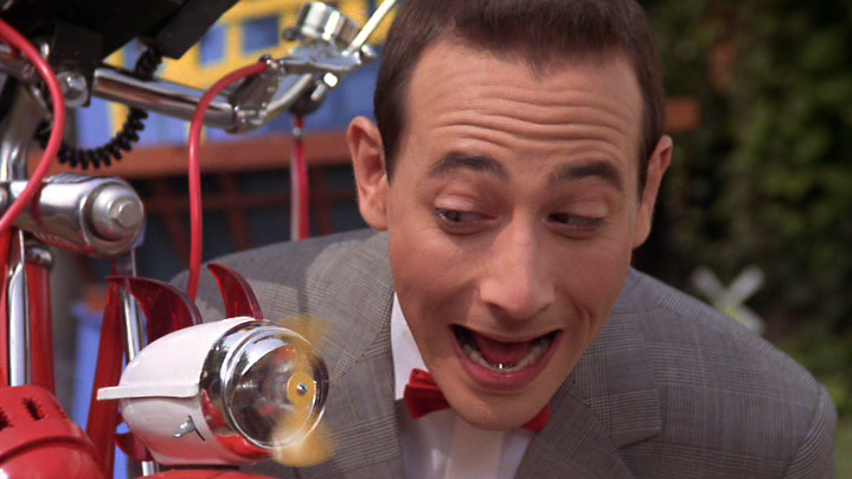
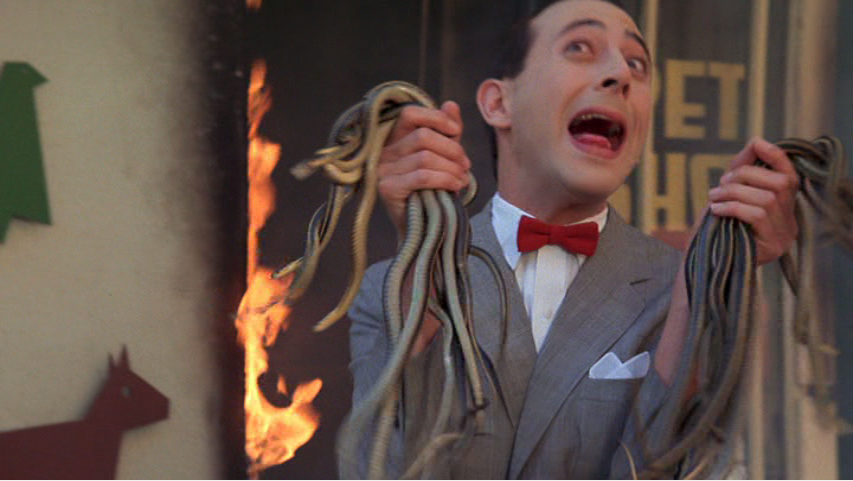

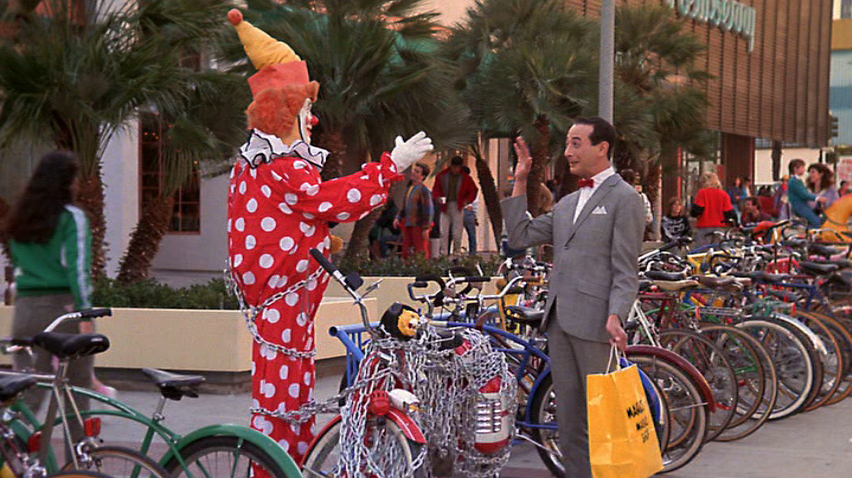
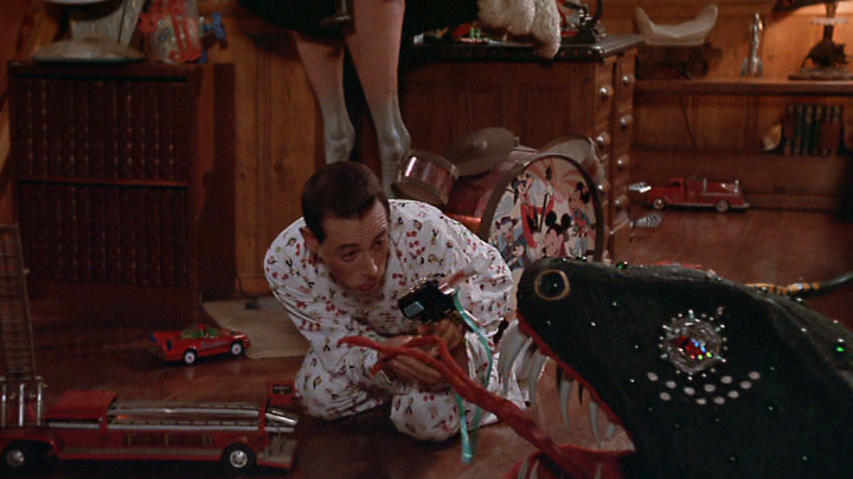

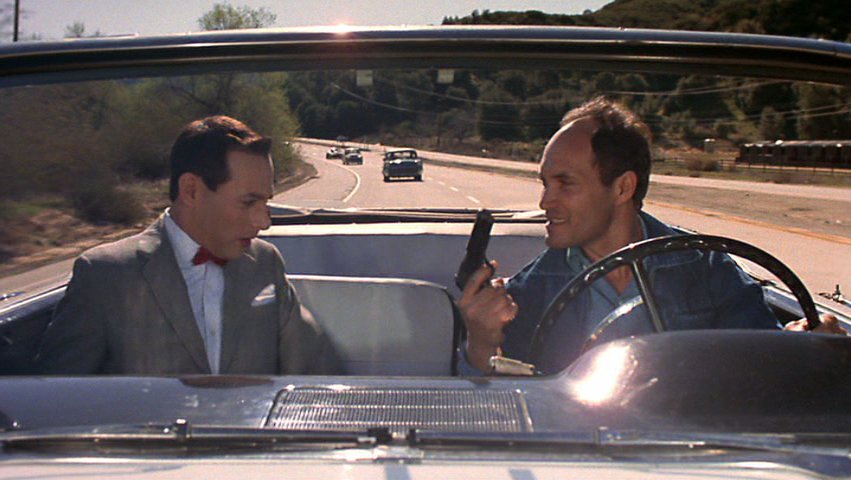
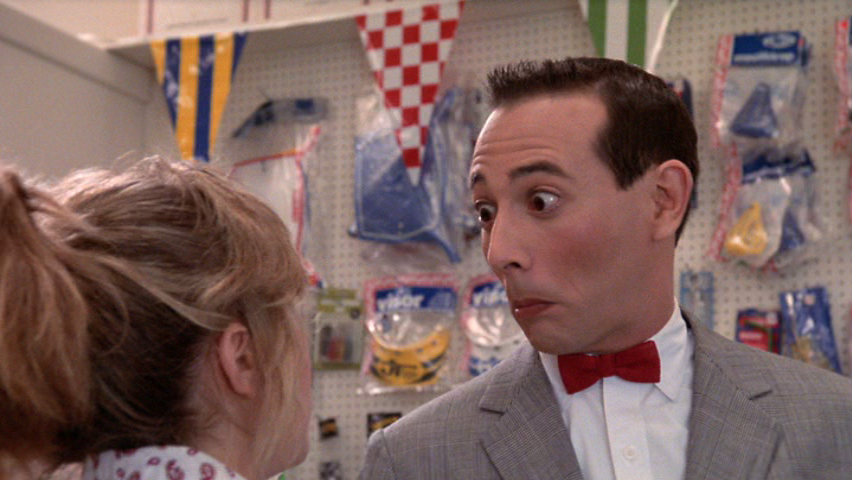
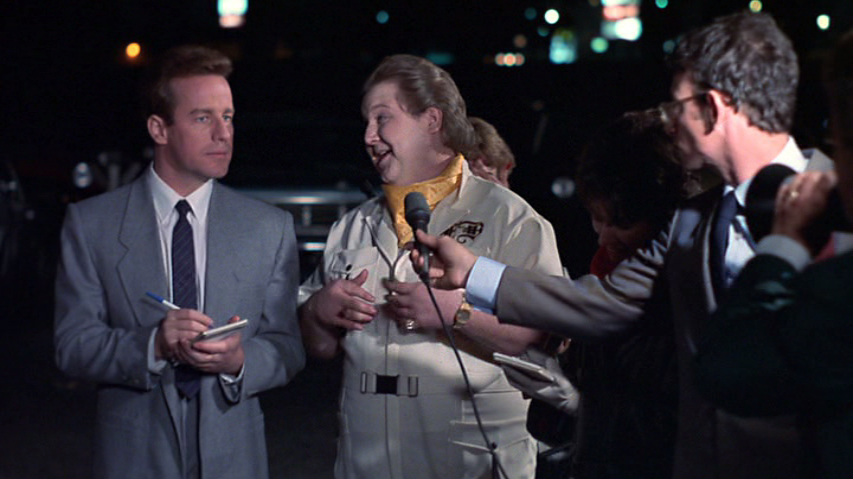
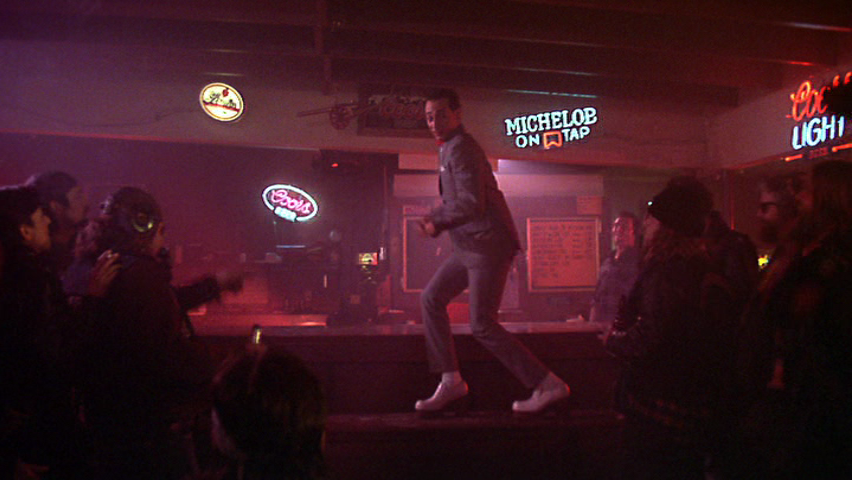
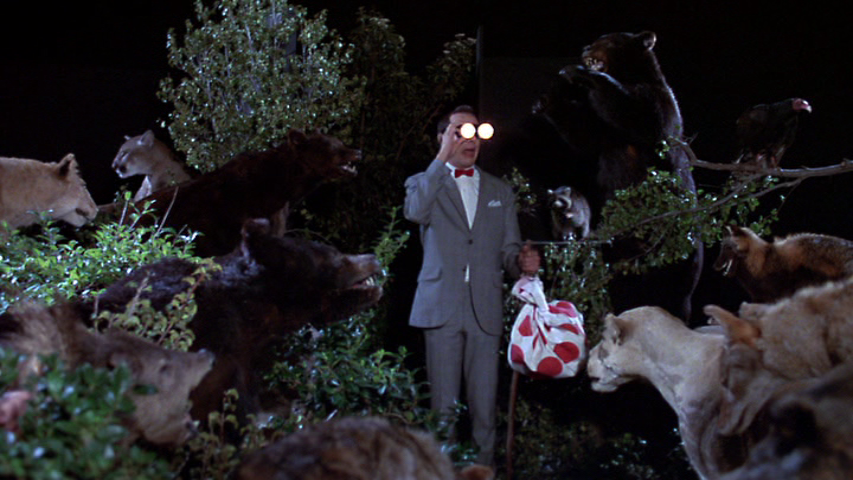
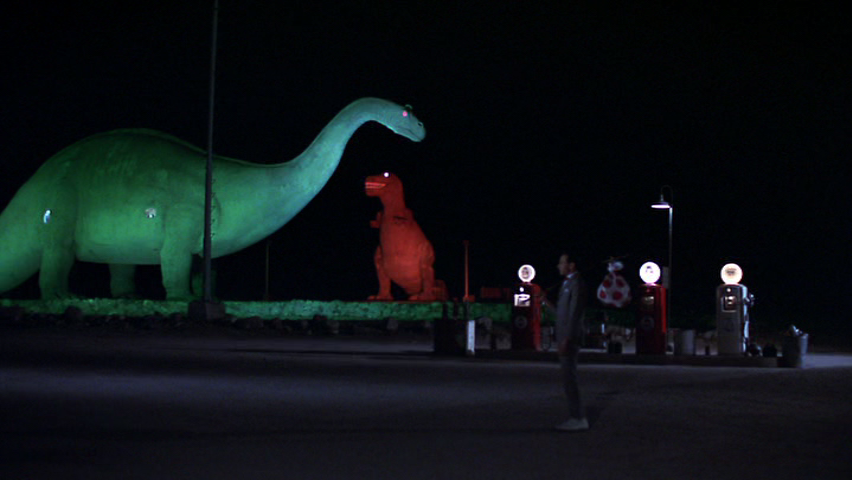
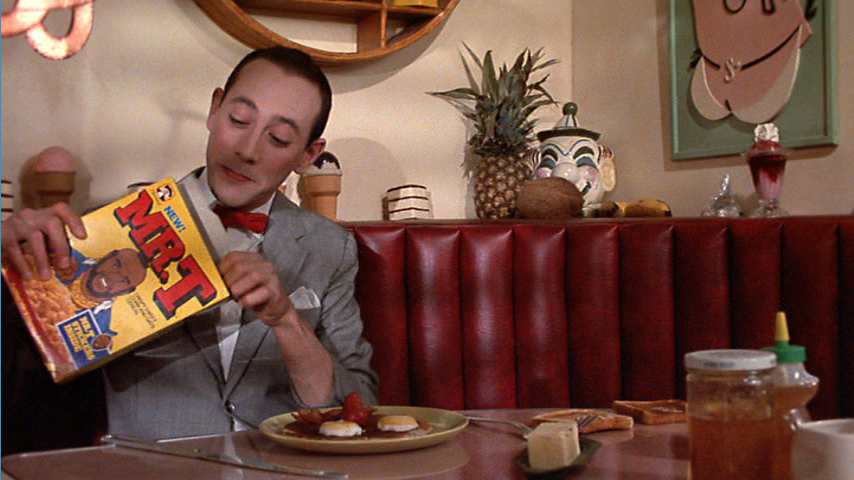

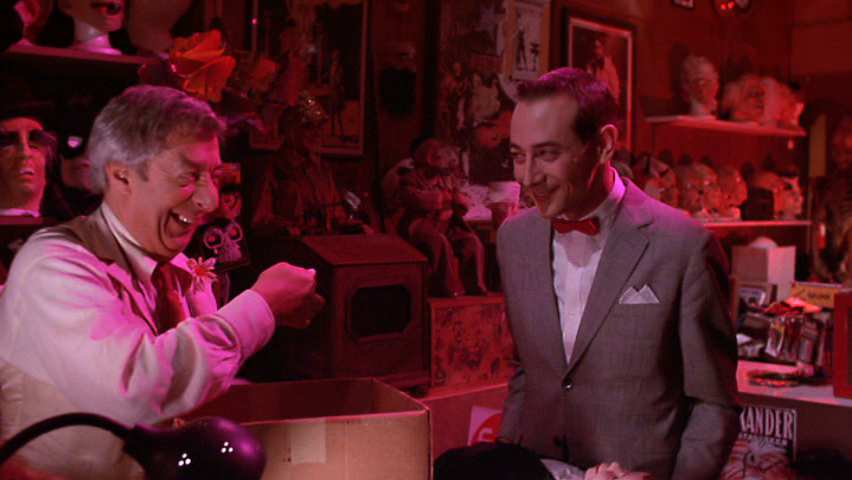
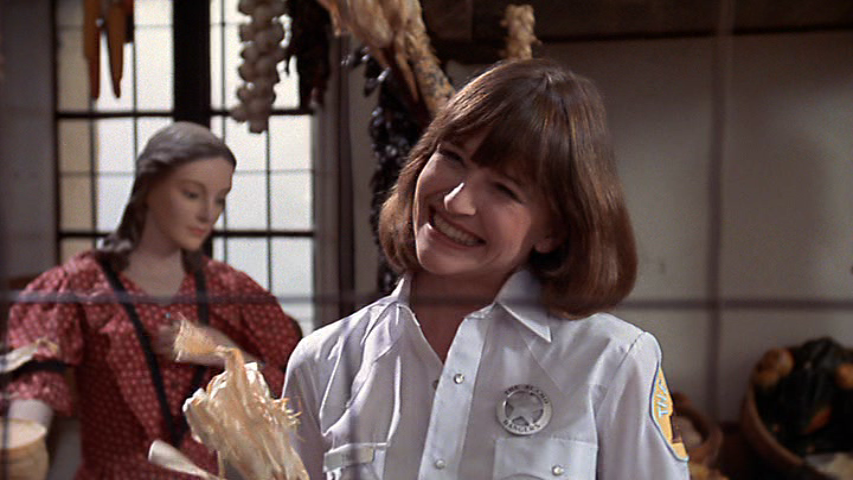
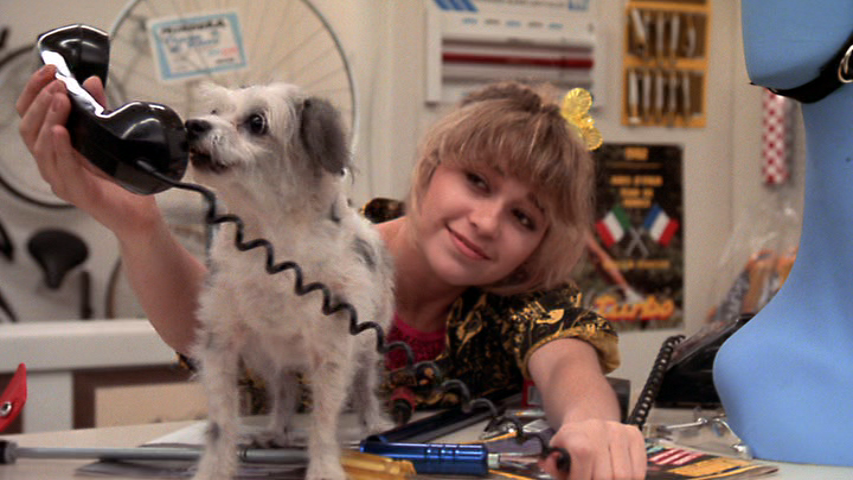
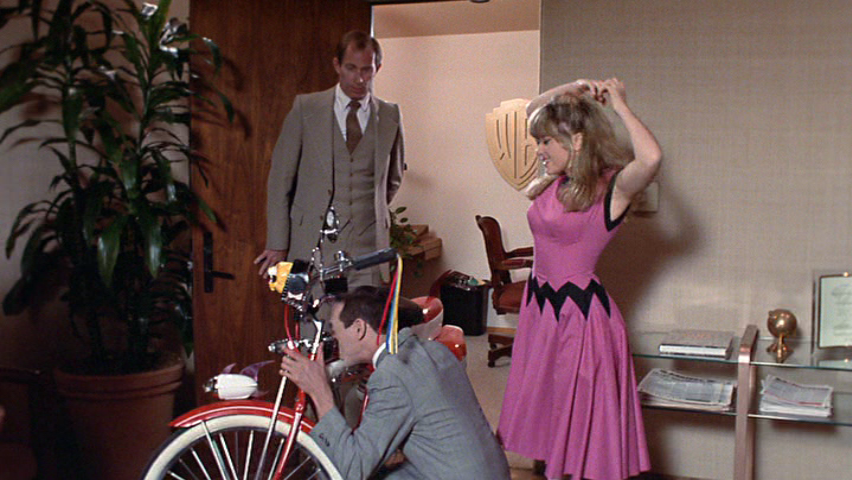
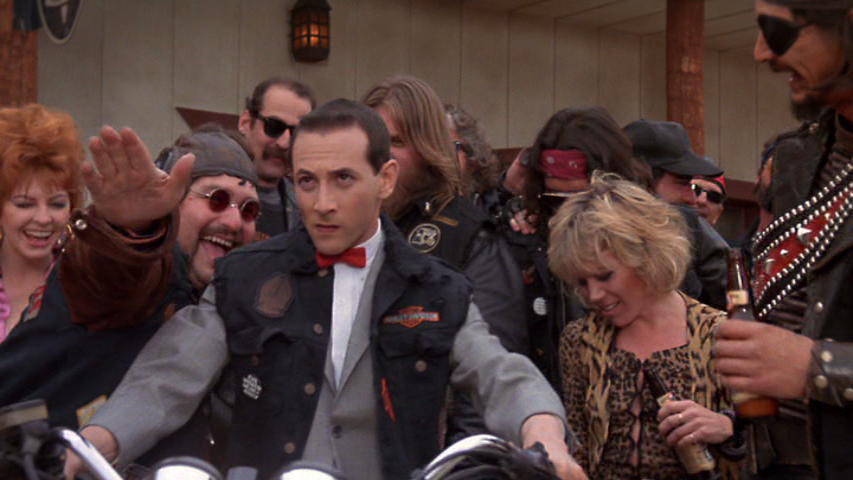
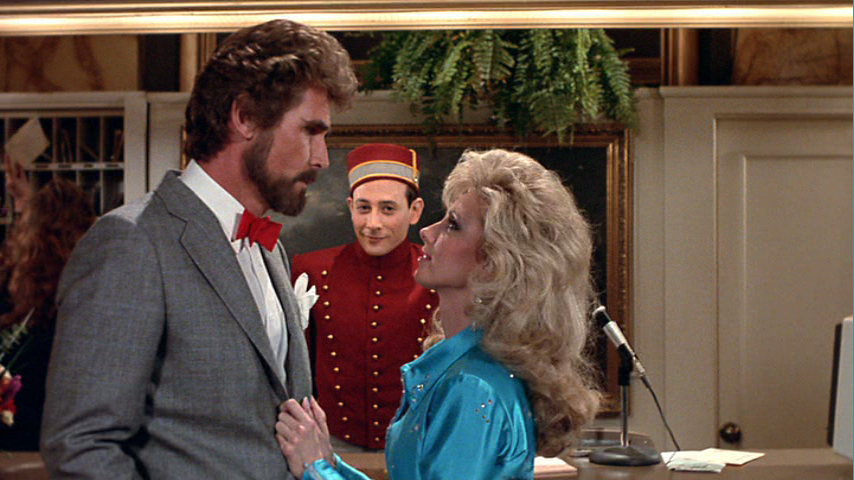
In college, my roommate and I went into the chapel after midnight and played the main theme from the movie on the organ.
.wavs or it didn’t happen.
As someone who is, was, and forever shall be a huge fan of Pee-Wee, it’s awesome to see your take on the PW films. I too have watched this movie far more times than i could possibly count over the past 30+ years. And never once has it failed to delight as much as it did that very first time seeing it in the small twin theater in my home town (sometimes there are privileges in being old!).
.
I could probably drone on endlessly about the flick, but instead i’ll just throw this little trivia out there (which you might already know) — not only did Elizabeth “Dottie” Daly (who even when i was just a 10 year old boy, i had a big kid-crush on) play Phoebe’s former singing partner on an early episode of “Friends” (where she takes Phoebe’s classic “Smelly Cat” song to use as a kitty litter jingle), but she also sang the title song of another excellent 80s classic and personal fave, “Better Off Dead”. She also briefly appeared in the film performing the song at the school dance towards the end of the film.
.
Looking forward to the Big Top Pee-Wee write up. I too have only seen the movie once (again, despite being a big PW fan), and even then i don’t think i made it all the way through the thing. I really need to truly watch it one of these days, and you may have finally given me the motivation to do so.
I take no responsibility for this decision…
An interesting bit of trivia for you, the locomotive pulling the train Pee Wee and the hobo ride also was one of the two locomotives hauling the train that destroyed the De Lorean in Back to the Future III. The locomotives were Southern Pacific S6 types, sold to the Ventura County Railway, the sale was fairly recent in 1985, so they were still in their old colors, though the engine number was quickly repainted to “11” as it is in the movie. By 1989, when BTTF 3 was filmed, the units were wearing a new coat of paint. The two locomotives that destroyed the De Lorean were numbers 9 and 11. 9 was in front, easier to spot the number on, in the film itself, the second locomotive’s number is not seen, but a still photo appearing in a kid’s book made from the movie shows the number.